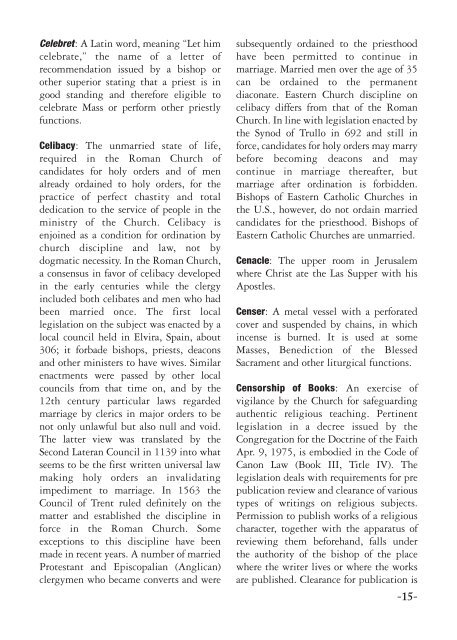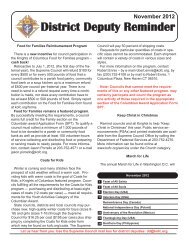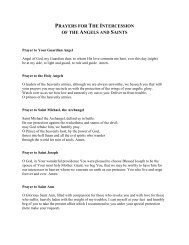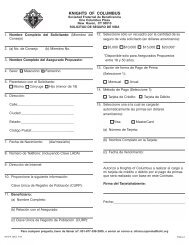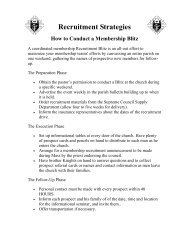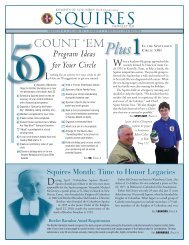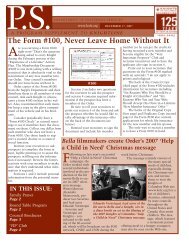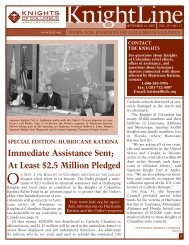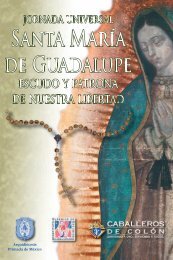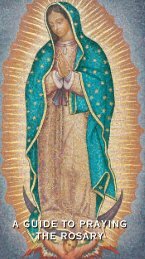CATHOLIC WORD BOOK - Knights of Columbus, Supreme Council
CATHOLIC WORD BOOK - Knights of Columbus, Supreme Council
CATHOLIC WORD BOOK - Knights of Columbus, Supreme Council
You also want an ePaper? Increase the reach of your titles
YUMPU automatically turns print PDFs into web optimized ePapers that Google loves.
Celebret: A Latin word, meaning “Let him<br />
celebrate,” the name <strong>of</strong> a letter <strong>of</strong><br />
recommendation issued by a bishop or<br />
other superior stating that a priest is in<br />
good standing and therefore eligible to<br />
celebrate Mass or perform other priestly<br />
functions.<br />
Celibacy: The unmarried state <strong>of</strong> life,<br />
required in the Roman Church <strong>of</strong><br />
candidates for holy orders and <strong>of</strong> men<br />
already ordained to holy orders, for the<br />
practice <strong>of</strong> perfect chastity and total<br />
dedication to the service <strong>of</strong> people in the<br />
ministry <strong>of</strong> the Church. Celibacy is<br />
enjoined as a condition for ordination by<br />
church discipline and law, not by<br />
dogmatic necessity. In the Roman Church,<br />
a consensus in favor <strong>of</strong> celibacy developed<br />
in the early centuries while the clergy<br />
included both celibates and men who had<br />
been married once. The first local<br />
legislation on the subject was enacted by a<br />
local council held in Elvira, Spain, about<br />
306; it forbade bishops, priests, deacons<br />
and other ministers to have wives. Similar<br />
enactments were passed by other local<br />
councils from that time on, and by the<br />
12th century particular laws regarded<br />
marriage by clerics in major orders to be<br />
not only unlawful but also null and void.<br />
The latter view was translated by the<br />
Second Lateran <strong>Council</strong> in 1139 into what<br />
seems to be the first written universal law<br />
making holy orders an invalidating<br />
impediment to marriage. In 1563 the<br />
<strong>Council</strong> <strong>of</strong> Trent ruled definitely on the<br />
matter and established the discipline in<br />
force in the Roman Church. Some<br />
exceptions to this discipline have been<br />
made in recent years. A number <strong>of</strong> married<br />
Protestant and Episcopalian (Anglican)<br />
clergymen who became converts and were<br />
subsequently ordained to the priesthood<br />
have been permitted to continue in<br />
marriage. Married men over the age <strong>of</strong> 35<br />
can be ordained to the permanent<br />
diaconate. Eastern Church discipline on<br />
celibacy differs from that <strong>of</strong> the Roman<br />
Church. In line with legislation enacted by<br />
the Synod <strong>of</strong> Trullo in 692 and still in<br />
force, candidates for holy orders may marry<br />
before becoming deacons and may<br />
continue in marriage thereafter, but<br />
marriage after ordination is forbidden.<br />
Bishops <strong>of</strong> Eastern Catholic Churches in<br />
the U.S., however, do not ordain married<br />
candidates for the priesthood. Bishops <strong>of</strong><br />
Eastern Catholic Churches are unmarried.<br />
Cenacle: The upper room in Jerusalem<br />
where Christ ate the Las Supper with his<br />
Apostles.<br />
Censer: A metal vessel with a perforated<br />
cover and suspended by chains, in which<br />
incense is burned. It is used at some<br />
Masses, Benediction <strong>of</strong> the Blessed<br />
Sacrament and other liturgical functions.<br />
Censorship <strong>of</strong> Books: An exercise <strong>of</strong><br />
vigilance by the Church for safeguarding<br />
authentic religious teaching. Pertinent<br />
legislation in a decree issued by the<br />
Congregation for the Doctrine <strong>of</strong> the Faith<br />
Apr. 9, 1975, is embodied in the Code <strong>of</strong><br />
Canon Law (Book III, Title IV). The<br />
legislation deals with requirements for pre<br />
publication review and clearance <strong>of</strong> various<br />
types <strong>of</strong> writings on religious subjects.<br />
Permission to publish works <strong>of</strong> a religious<br />
character, together with the apparatus <strong>of</strong><br />
reviewing them beforehand, falls under<br />
the authority <strong>of</strong> the bishop <strong>of</strong> the place<br />
where the writer lives or where the works<br />
are published. Clearance for publication is<br />
-15-


